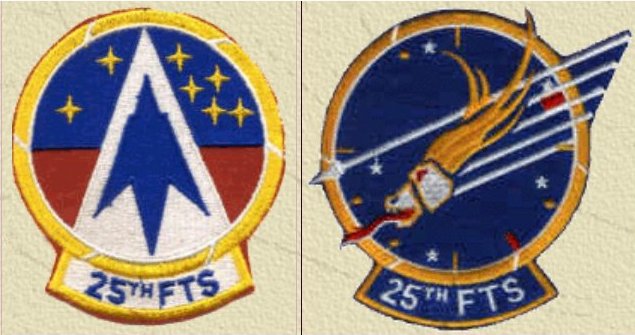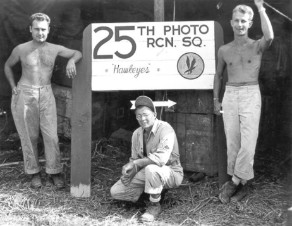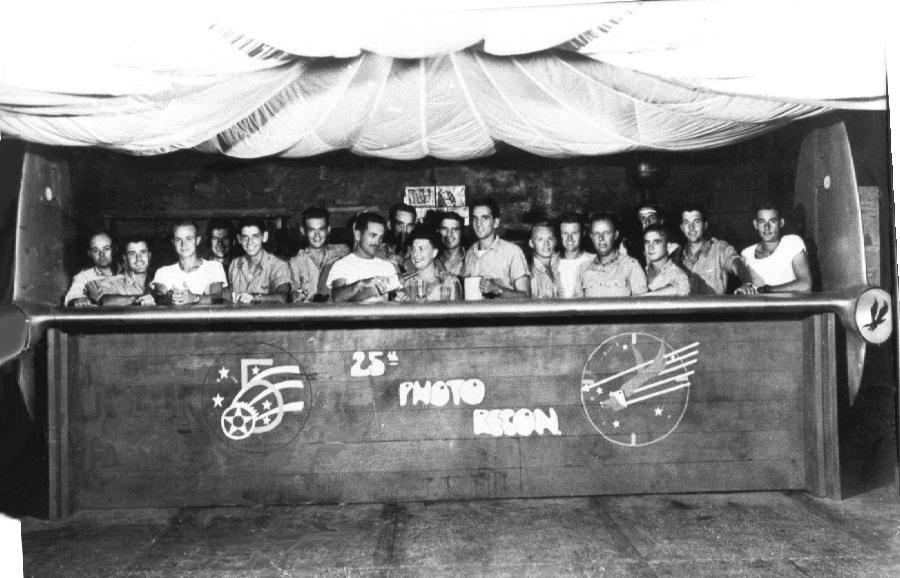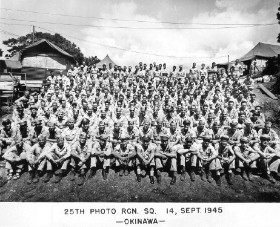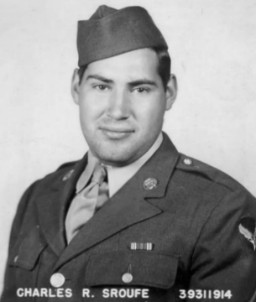The 25th Flying Training Squadron began its proud heritage as the 25th Photographic Reconnaissance Squadron on 5 February 1943 at Peterson Field, Colorado. The 25th trained in the F-5, the reconnaissance version of the P-38 Lightining, at Raton, New Mexico, and Thermal, California, before being shipped to their first operational base at Port Moresby, New Guinea.
Prior to leaving the United States, squadron personnel held a contest to develop an acceptable insignia. The squadron's insignia is a composite of the ideas of the original squadron personnel which culminated in the officially approved emblem we wear today. It represents an aerial camera with wings; the five bars stand for the 5th Air Force; the red marks at two and five o'clock stand for the 25th; the five sars represent the Southern Cross constellation; and the lance stands for combat.
During World War II, the squadron flew reconnaissance missions in support of Allied operations in the Pacific and made numerous moves throughout the theater as Allied forces "island hopped" their way toward Japan. At war's end, the 25th was stationed in Okinawa and eventually moved to Japan where the squadron was deactivated in 1949. Reactivated in 1955, the 25th flew RF-84 aircraft out of Larson AFB, Washington, until 1957 when they were again deactivated.
On 1 November 1972, Air Training Command, desiring to give
its units a meaningful heritage on which to build, redesignated
the 3576th Pilot Training Squadron at Vance the 25th Flying Training
Squadron. Today, the squadron trains student pilots in the Northrop
T-38 Talon supersonic jet trainer and continues the proud heritage
passed on from the 25th Photo Reconnaissance Squadron. On 1 July
1993, the 25th Flying Training Squadron became part of the 19th
Air Force, Air Education and Training Command.
Lineage
Constituted 25th Photographic Reconnaissance Squadron on 5 Feb 1943. Redesignated 25th Photographic Squadron (Light) on 6 Feb 1943. Activated on 9 Feb 1943. Redesignated: 25th Photographic Reconnaissance Squadron on 11 Aug 1943; 25th Tactical Reconnaissance Squadron on 24 Jan 1946. Inactivated on 1 Apr 1949. Redesignated 25th Strategic Reconnaissance Squadron, Fighter, on 4 Nov 1954. Activated on 24 Jan 1955. Inactivated on 1 Jul 1957. Redesignated 25th Flying Training Squadron on 14 Apr 1972. Activated on 1 Nov 1972.
Assignments
6th Photographic (later 6th Photographic Reconnaissance and Mapping; 6th Photographic Reconnaissance; 6th Photographic; 6th Reconnaissance) Group, 9 Feb 1943 (attached to V Fighter Command after 10 Feb 1946); V Fighter Command, 27 Apr 1946; 315th Composite Wing, 31 May 1946; 71st Reconnaissance (later, 71st Tactical Reconnaissance) Group, 28 Feb 1947–1 Apr 1949 (attached to 315th Composite Wing to Nov 1947). 71st Strategic Reconnaissance Wing, 24 Jan 1955–1 Jul 1957. 71st Flying Training Wing, 1 Nov 1972; 71st Operations Group, 15 Dec 1991–.
Stations
Colorado Springs, CO, 9 Feb–22 Oct 1943; Sydney, Australia, 19 Nov 1943; Brisbane, Australia, 25 Nov 1943–19 Jan 1944; Lae, New Guinea, 3 Feb 1944; Nadzab, New Guinea, 7 Feb 1944; Biak, 23 Jul–16 Nov 1944; Dulag, Leyte, 24 Nov 1944; San Jose, Mindoro, 3 Jan 1944 (detachment at Dulag, Leyte, to 6 Feb 1945; air echelon at Clark Field, Luzon, 14 Jun–14 Jul 1945); Okinawa, 9 Jul 1945; Chofu, Japan, 27 Sep 1945; Itazuke AB, Japan, 10 Feb 1946; Itami, Japan, 30 Mar 1946–1 Apr 1949. Larson AFB, WA, 24 Jan 1955–1 Jul 1957. Vance AFB, OK, 1 Nov 1972–.
Aircraft
In addition to P–38/F–5, 1943–1945, included B–25, 1944; in addition to P–51/F–6, 1946–1949, included L–5, 1946, and F–2, 1947–1948. RF–84, 1955–1957. T–38, 1972–.
Operations
Combat in Southwest Pacific and Western Pacific, 5 Feb 1944–14 Aug 1945. Not operationally manned or equipped, Nov 1945–Feb 1946. Photographic reconnaissance in western United States, 1955–1957. Undergraduate pilot training for USAF, Air National Guard, Air Force Reserve, and selected foreign allies, 1 Nov 1972–.
Honors
Service Streamers. None.
Campaign Streamers. World War II: Air Offensive, Japan; China Defensive; New Guinea; Bismarck Archipelago; Western Pacific; Leyte; Luzon; Southern Philippines; Ryukyus; China Offensive; Air Combat, Asiatic-Pacific Theater.
Armed Forces Expeditionary Streamers. None.
Decorations. Distinguished Unit Citations: Philippine Islands, 18–[20] Sep 1944; Japan, 9 Aug 1945. Air Force Outstanding Unit Awards: 1 Jan–31 Dec 1975; 1 Jan 1977–30 Apr 1978; 1 May 1982–30 Apr 1984; 1 Apr 1987–31 Mar 1989; 1 Apr 1989–31 Mar 1990. Philippine Presidential Unit Citation (WWII).

